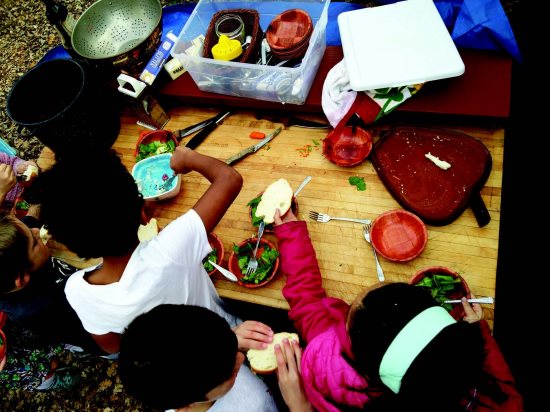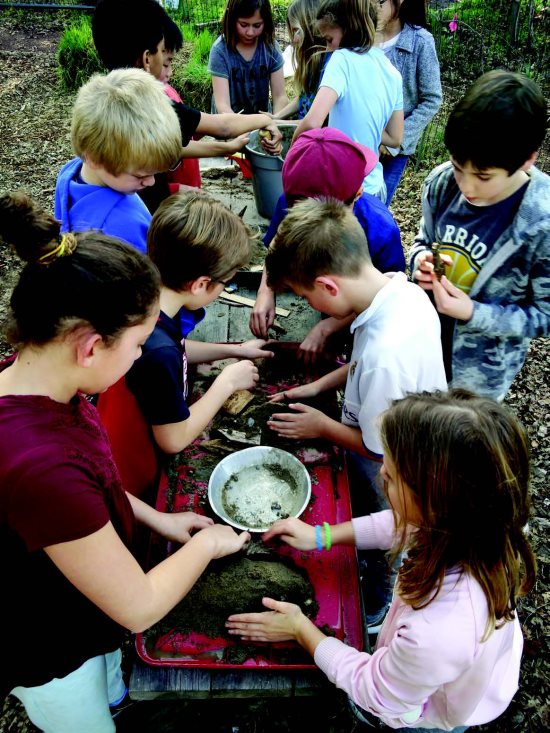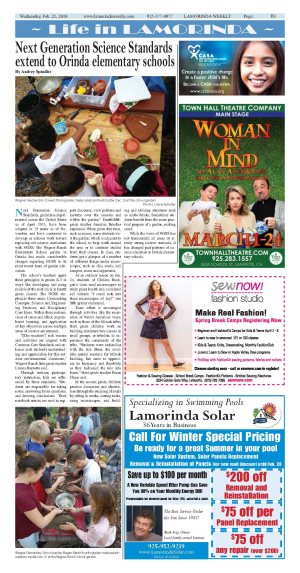| | Published February 21st, 2018
| Next Generation Science Standards extend to Orinda elementary schools
| | | By Audrey Spindler |  | | Wagner teacher Erin Crowe's third-graders make salad and herb butter Dec. 15 at the school garden. Photos Lilana Spindler |
Next Generation Science Standards, guidelines implemented across the United States as of April 2013, have been adopted in 19 states as of November, and have continued to develop as schools work toward replacing old science curriculum with NGSS. The Wagner Ranch Elementary School garden in Orinda has made considerable changes regarding NGSS in its most recent form of garden education.
 The school's teachers apply these principles in grades K-5 in ways like developing and using models of the rock cycle in fourth grade classes. The NGSS emphasize three areas: Crosscutting Concepts, Science and Engineering Practices, and Disciplinary Core Ideas. Within these notions, ideas of cause and effect, inquiry-based learning, and application of key objectives across multiple areas of science are stressed.
The school's teachers apply these principles in grades K-5 in ways like developing and using models of the rock cycle in fourth grade classes. The NGSS emphasize three areas: Crosscutting Concepts, Science and Engineering Practices, and Disciplinary Core Ideas. Within these notions, ideas of cause and effect, inquiry-based learning, and application of key objectives across multiple areas of science are stressed.
 "[The teachers'] rich lessons and activities are aligned with Common Core Standards and enhance each student's understanding and appreciation for this outdoor environmental classroom," Wagner Ranch first-grade teacher Linnea Burnette said.
"[The teachers'] rich lessons and activities are aligned with Common Core Standards and enhance each student's understanding and appreciation for this outdoor environmental classroom," Wagner Ranch first-grade teacher Linnea Burnette said.
 Through outdoor, participatory instruction, kids are influenced by these standards. "Students are responsible for taking notes, answering focus questions, and drawing conclusions. Their notebook entries are used to support discourse, view patterns and systems over the seasons and within the garden," fourth/fifth-grade teacher Annalisa Brucker explained. When given free time, such as recess, some students visit the garden, which is adjacent to the school, to help work around the area or to continue studies from their classes. In class, students get a glimpse of a number of different things under microscopes, such as chia seeds, soil samples, moss and organisms.
Through outdoor, participatory instruction, kids are influenced by these standards. "Students are responsible for taking notes, answering focus questions, and drawing conclusions. Their notebook entries are used to support discourse, view patterns and systems over the seasons and within the garden," fourth/fifth-grade teacher Annalisa Brucker explained. When given free time, such as recess, some students visit the garden, which is adjacent to the school, to help work around the area or to continue studies from their classes. In class, students get a glimpse of a number of different things under microscopes, such as chia seeds, soil samples, moss and organisms.
 At an outdoor lesson on Jan. 24, students of Chelsea Rustigan's class used microscopes to study plant health and calculated soil volume. "I could look into these microscopes all day!" one fifth-grader exclaimed.
At an outdoor lesson on Jan. 24, students of Chelsea Rustigan's class used microscopes to study plant health and calculated soil volume. "I could look into these microscopes all day!" one fifth-grader exclaimed.
 Team effort is encouraged through activities like the recreation of Native American ways, such as those of the Miwok tribe; third grade children work on building miniature tule canoes in small groups, or tribelets, to experience the community of the tribe. "Students were unfamiliar with the tule fibers, the available natural resource for Miwok building, but came to appreciate its buoyancy and flexibility as they fashioned the tule into boats," third-grade teacher Susan Chase said.
Team effort is encouraged through activities like the recreation of Native American ways, such as those of the Miwok tribe; third grade children work on building miniature tule canoes in small groups, or tribelets, to experience the community of the tribe. "Students were unfamiliar with the tule fibers, the available natural resource for Miwok building, but came to appreciate its buoyancy and flexibility as they fashioned the tule into boats," third-grade teacher Susan Chase said.
 In the second grade, children practice discussion and observation through the studying of rocks by sifting in creeks, sorting rocks, using microscopes, and building and utilizing structures such as adobe bricks. Sometimes students benefit from the more practical purpose of a garden, making salad.
In the second grade, children practice discussion and observation through the studying of rocks by sifting in creeks, sorting rocks, using microscopes, and building and utilizing structures such as adobe bricks. Sometimes students benefit from the more practical purpose of a garden, making salad.
 While the wave of NGSS has not transcended all areas of already strong science curricula, it has changed past patterns of science education in Orinda elementary schools.
While the wave of NGSS has not transcended all areas of already strong science curricula, it has changed past patterns of science education in Orinda elementary schools.


|
 | | Wagner Elementary School teacher Megan Natal's fourth-graders make weatherization models Jan. 31 at the Wagner Ranch School garden. | | | | | | | | | | | |




